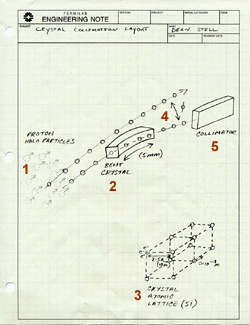Deconstruction: Collimation
1
In high-energy collisions, luminosity, or beam brightness, isn't the only thing to consider; low background noise at the detectors is also important. When wayward particles bounce around inside detectors, they can mimic real collisions, muddy results, and even damage parts of the collider. To cut down on all this mess, scientists need tight, narrow proton beams. That means "collimating," or shaving off the diffuse outer edge of the beam.
2
On October 5, 2005, Fermilab scientists tested "channeling," a creative method for shaving the beam's ragged outer edges in the Tevatron. Dean Still, along with Vladimir Shiltsev and others in the Tevatron Department at Fermilab, adapted an idea that Nikolai Mokhov and others had proposed for the Superconducting Super Collider in 1991. The new experiment demonstrated that protons could be channeled through a 5-millimeter piece of bent silicon crystal to scrape the proton beam. The results showed substantial improvement in channeling efficiency over previous attempts. And at 1 TeV, they demonstrated channeling at higher energies than ever before.
3
The trick behind the bent-crystal method is control. "Crystals are just atoms with lots of ordered space between them," explains Mokhov. When the crystal is placed into the proton halo (the outer edge of the beam) the atoms channel the protons along the crystal. "It's like a gutter on the edge of a bowling lane," says Still. "The protons in the halo get caught in the ‘gutter' of the crystal lattice and are bent away from the core of the proton beam." The particles are routed from the bent crystal to a collimator, never to be seen again inside the beam.
4
Standard collimation in the Tevatron is achieved with a two-step system. First, small tungsten "targets" are placed just inside the halo to deflect halo protons away from the beam. In the second step, some of these particles are absorbed by 1.5-meter-long stainless-steel collimators; others bounce past them and make another round through the Tevatron. The main problem with this method is that a tungsten target does not route particles in any particular direction. "The target is just a scatterer," says Still. "Tungsten is so hard that when particles hit it, they bounce off in different directions." Bent-crystal collimation is better because it routes particles in very specific directions.
5
"Traditional two-step collimation allows any particular halo-particle, on average, to circulate about 100 times before it is absorbed by the collimator," says Still. This could be an issue in higher-energy colliders like the Large Hadron Collider, where wayward particles might be more than a nuisance: they might actually drill holes in the superconducting magnets and other accelerator hardware. The bent-crystal method cuts down the average number of trips by a deflected particle to about twenty trips around the Tevatron before it is absorbed by a collimator. Although LHC scientists plan to use traditional two-step collimation for Run I (using special carbon-carbon collimators to protect accelerator equipment), they are looking toward new methods, including crystal collimation, for Run II in the year 2011.
Text: Siri Steiner
Engineering note: Dean Still, Fermilab
Click here to download the pdf version of this article.







